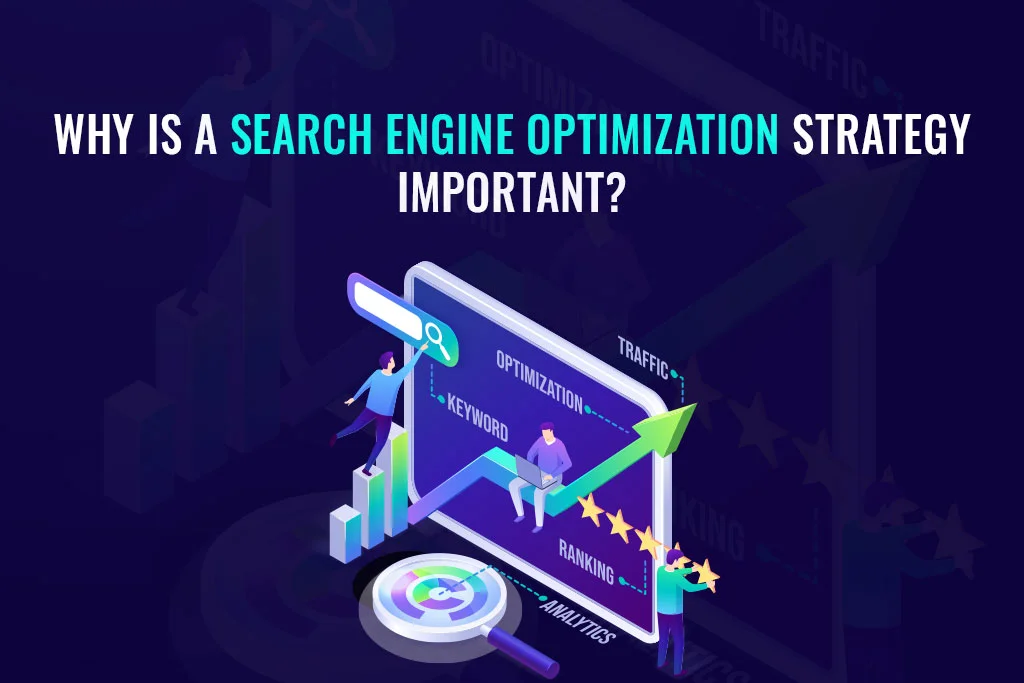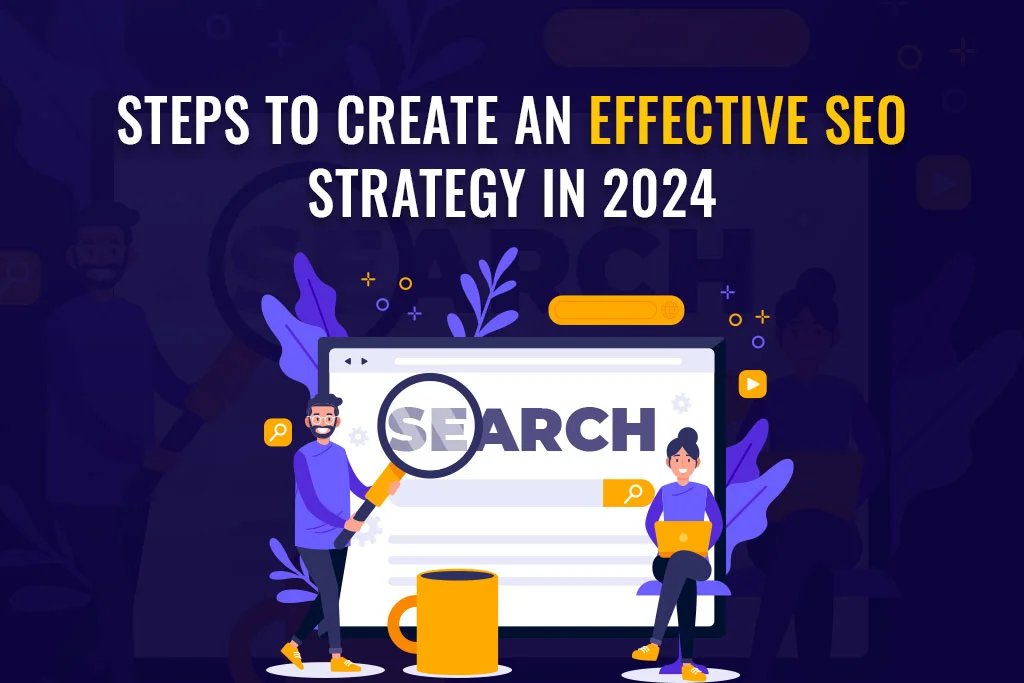How to Create an Effective SEO Strategy in 2024?

SEO (Search Engine Optimization) invests in systematically improving a website’s visibility in SERPs (search engine result pages), thus leading to neutral organic traffic and sales increase for the represented business. The main idea of a successful SEO campaign includes many components that Adjust simultaneously to achieve results from users’ requests (target adequate keywords), search engine optimization of page titles (meta tags editing) as well as organizing internal links, increasing the uptime of the website, and building high-quality backlinks (Review the results of site visitors and competitors).
The SEO strategy encompasses all aspects of a digital marketing campaign that can lead to an effective online presence. It is quite important for companies that want to triumph within their markets through their segments, as customers are becoming more conscientious of the highly competitive digital age.
What Is An SEO Strategy?
An SEO strategy is an implemented plan that covers creating, optimizing, and promoting content to increase its visibility in the search engine results pages for free. As a result, website traffic would be growing organically. It is a tightly knit and intricate group of services, including phrase optimizations, on-page optimization, technical SEO, and web building.
In other words, an SEO strategy is what you follow when you want your website to occupy the top positions of popular search engines like Google without paying for the ads.
Why is a Search Engine Optimization Strategy Important?

Effective SEO is undeniable in the sphere of online business activities nowadays. Its importance lies in shaping organic traffic and search engine visibility, which cannot be ignored if one wants to register online business growth. The following paragraphs explain significant considerations for those who own websites and business owners who need to consider having a well-thought-out SEO strategy as their top priority.
Building Trust and Credibility:
A good SEO strategy not only helps create reputation and reliability for visitors by having your website on the first or at least on the first page of a search engine; it also aids in building trust and credibility towards a brand and its products. The top places in the SERP reflect that your site has quality content for users, and others deem it worth reference through backlinks. This causes users to stay on the website longer and reduce bounce rates, increasing conversions.
Competitive Advantage:
Consequently, through SEO strategies that use cutting-edge techniques, you are at an advantage over your competitors by getting top ratings for target keywords. By doing this, you will gain an advantage over other sites because most visitors go for those located at the top of Google’s search results rather than those lower down. Besides this, it is also helpful to learn from what your competitors are including. It can give you an idea of how they conduct their SEO or where you are still behind so that you can incorporate this into your SEO plan, and it might provide you with more yields when doing this.
Cost-Effectiveness and Long-Term Sustainability:
An SEO strategy is a cost-effective channel compared to other digital marketing channels, such as Pay-Per-Click (PPC) ad campaigns, as it focuses on people who actively search for products similar to yours and thus reach out to the interested audience. If the PPC campaigns give instant results, then their duration of effect is short and can become costly as time goes on. Compared to a poor SEO strategy, which is short-lived and requires more PPC mechanisms, excellent SEO performance is a time-tested one that stays on top without much interruption by paid ads.
Improved Visibility and Organic Traffic:
The most crucial aim of an SEO strategy is to increase search engine users’ usage of your website through SERPs. A good rank will be achieved by looking for the most relevant keywords and using clever optimization methods, resulting in more traffic to the website and users seeing it. Search users will tend to click on top results, which undoubtedly makes it possible to diminish organic traffic.
Steps to Create an Effective SEO Strategy in 2024:

Set your Goals:
Traffic is the key to the campaign’s success, and the quality of the traffic matters most for the SEO campaign.
Having the website visited by thousands of people is magnificent, but what benefit does it serve if no sales are generated? The best SEO approach does not aim to have more website traffic but to be a strategy that will boost revenue.
For instance, two websites contend against each other using different SEO tactics.
Website A: Thanks to SEO, 200 technical people visit this site monthly, and 10 become customers. This implies that this site has generated 50 sales in a month so far. Good!
Website B: Attracts 10,000 visitors a month through SEO, but only 0.1% of visitors become customers since it targets high volume but low-quality traffic.
The point here is also… that a website’s growth may diverge sales accordingly, but website A may get the same number of sales as website B despite the latter getting high traffic. This is because the SEO strategy for website B is only to drive traffic but does not consider the quality of traffic and what the searchers want.
Create focused goals for getting more leads and sales and develop an SEO plan to optimize revenue rather than traffic conversion. This strategy will get you the best results from SEO services.
Choose Your Keywords:
Keyword research is the most essential part of SEO and is a basis for your future strategy. One of the most important things to remember is to pick the right keywords, as using the wrong keywords would show the wrong type of people’s interest in your website.
A hit at the right keyword to your business site will reward you with all the new customers you didn’t know existed. Keyword research is a non-skippable step to getting it done, so please don’t rush; handle it carefully.
Here is what you need to do to get the best keyword and top the SEO.
Create Keyword Theme:
The act of selecting keywords is not the true aim. You need to look at the topics (themes) and find the words that fit together.
For example:
For instance, if you select keywords for an online shoe store, you need to settle for words that are both the most appropriate and in high demand.
For instance, if you are selling these products, the product keyword list can be divided into ‘running shoes,’ ‘walking shoes,’ and ‘tennis shoes.’
Then, you must select the keywords relevant to each theme and club them together. Hence, the keyword planner will autosuggest those longer tail terms for ‘tennis shoes’ such as ‘Nike tennis shoes’ or ‘women’s tennis shoes,’ among others.
You have undoubtedly been building up topic-based keywords for yourself, which is the secret to treating keyword research.
Keep Keywords in a List:
Imagine you have a few keyword themes in your search, like ‘Fashion’ and ‘Know how to dress beforehand.’ Now, bucket your keyword list into the themes you identified in the first step.
Let there be many data sources and SEO automatic means for finding keywords, and you should utilize all you can.
Pro-tip: Take the advice not to stick to one tool to know all the terms you need.
Datasets available but not limited to you include:
- 1. Google Keyword Planner (registration needed in Google Ads) (for free)
- 2. Google Trends (free)
- 3. Google My Business (free)
- 4. Google Search Console (free)
- 5. Ahrefs (paid)
- 6. SEMrush (paid)
- 7. Keywords Everywhere (paid)
Find the Best Keyword From Your List:
When you reach this point, your strategy for selecting the final keywords must be well thought out and planned.
Everything comes down to finding the right balance between being ‘too competitive’ and ‘utterly irrelevant to your niche. ‘
Identifying ‘Sweet Spot’ keywords is crucial, and here’s how to do it:
- 1. Convene your keyword list, clip out the high and moderate-volume words, and place them alongside each other. Don’t worry if you don’t have Ahrefs; it’s one of the best available tools. You can also use an Excel spreadsheet. Organizing the keyword list from high to low volume frequency assists us in looking up and brainstorming the topic.
- 2. Finally, fall back on the extinct point on your list, which is near the halfway point. Here, it is where you probably rock, and there will be your pearl, which is the ‘sweet spot’ keyword to choose among the options.
- 3. Now, go through the keywords ‘keyword themes’ from the previous stage and select the ones most relevant to your content.
At this step, you may find one or two great keywords for each and others that are too good but don’t fit into any of your keyword themes. All right, those can be crucial information for the moment, but it’s better to solve them in the future if possible.
One of my examples is that I have an e-commerce marketing agency that offers email marketing services, but I don’t have a single page created for this. Since keywords are at the forefront of every user’s search query, this is one of the central ideas I want to emphasize. I will add a new page during the content creation part of my search engine optimization strategy.
After you have located all the potential sweet spot keywords, the next step is where one may start to think and plan on the type of content that will not only attract users but will be able to draw more organic traffic.
Craft Winning Content:
Crafting winning content consists of 2 main components.
1. Understanding Search Intent
2. Content creation
I’ll explain each component in detail below.
Focus on Your Intent:
Understanding the search intent is very important to write content that works well. You need to understand why the audience is typing in your screened keywords and the intention behind it to rank your content. For example, Someone who wants to learn about mountain bike tips comes across this kind of article by searching for “mountain bike tips.”
The individual wants to improve mountain bike riding since it is so much fun. They wouldn’t care to see it if they were climbing the rating of the top 10 mountain bikes for sale…or an eCommerce product page offering the customers to buy mountain bikes online.
This criterion is optional to this customer, but they must know why and how to do it better. Keyword research sounds like an easy concept, but looking deeper might get tricky, so you should devote some time to every keyword you’ve decided to apply.
Pro tip: Although you may sometimes feel that you don’t know the intent behind using your keywords, look on the brighter side. You can easily find out how people search for these keywords by entering them into Google and searching the search results.
Write Content Which Ranks:
I heard that often enough; you might have gotten tired of it…
However, this leads me to a very intuitive question: What does it mean? (What does being green resemble?).
Short answer: The dump of content adds little to less ‘fluff’ that may distract the searcher from comprehending the main points of the user’s query.
And while there’s no proven success formula to “publishing great content,” there are some simple tips you can apply that can make all the difference:
1. Stay calm with your introductions-limit them to at most five sentences.
2. Keep your information short and closely interconnected (not more than 200-300 words), and always use subtitles to guide your reader.
3. Add exciting and clear graphics, including images, graphs, and tables, to present your answer fully.
4. Apply the practicality principle—give your audience a great tip or something they can use immediately. This might be tedious, but at least you can comprehend the terminology that the audience is aware of.
5. Ensure you review and evaluate the ranking content closely, looking for places where you can (and cannot) improve your work compared with the top rank. Does your content provide more value than the current SERP? (SERP stands for search engine result page). But if not, then what have I left on?
Advance Link Building:
Creating a link-building plan simply means enhancing the elements on your site that aren’t on the page themselves. With this in mind, it is about developing an effective link structure that enables your website to get noticeable, high-quality links.
If you look at what makes the chain building work magic, it is to earn great backlinks, and that will only come with dominating the email outreach and the idea of stealing competitors’ links and writing fantastic guest posts.
How you can build a link-building strategy that works is…
Effective Outreach Strategies:
If you can become a master of email outreach, you stand a good chance of lining up some high-quality backlinks that will give you an advantage over your competition.
For most people, the reason they don’t try cold email outreach is that they either don’t do it or underestimate the amount of hard work needed to perform it well.
Here’s the crazy part… Spamming emails won’t be as effective, but you’ll still have to put a little effort in and will likely receive many rejections. It is ok with that; nonetheless, it makes it worth it.
Important: Before diving in and sending that cold outreach email with the chance of no results, your website should have at least one linkable asset. This is a fundamental article, and everybody is going to associate their digital genesis with linking their landing pages with sales pages.
Guest Posting Strategies:
What if your website does not have a blog or anything to link to so that you can still have high-authority backlinks? Finally, guest posting is a good approach.
Quality Link building is understanding the golden rule that quality over quantity is always the goal. We don’t do guest posting for free, as we have limited resources and always want to secure the best outcome for all parties involved.
Thus, that can be done by guest posting on sites that are authoritative and within the bounds of your niche. But if you don’t get much success at the beginning, just don’t worry. You can start off with some sites that happily accept guest posts and are even willing to have a few words from you! Having guest-posted on several big sites, better than 1 or 2 quality posts of smaller ones, will make you a better offer pitcher.
Tracking Results:
Evaluating how SEO influences your website not only helps you discover future opportunities but also looks for problems to enhance the site’s rankings.
Since you may be leveraging a particular SEO strategy for a specific client, the desired result will be to show them how the plan performs now and then.
Below are some KPIs for implementing an SEO strategy in your business.
Monitor Organic Trafic:
The fantastic thing is that Google Analytics allows you to track your website’s organic site traffic. Also, the data presented is accurate and abundantly information-rich, covering traffic behavior, total visitor numbers, and much more.
Here are instructions on how to monitor your campaign organic traffic:
- 1. Enter Google Analytics to explore the ‘Acquisition’ tab on the left side of your observation window.
- 2. From this home page, choose the ‘all traffic’ option, and under ‘channels,’ select ‘channels.’
- 3. You can select the dates by clicking the date range button on the Google Analytics dashboard, located at the right-hand corner of the screen.
- 4. Choose your month for tracking and the month to be compared just by clicking on the ‘compare to’ button to track the changes in traffic across different months.
Track Keywords Ranking:
Google Search Console (GSC) is another outstanding tool for studying the results of your SEO strategy. GSC helps you get exact keywords that generate most of your site traffic as a better tool. In such a way, you’ll be in a better position to take the required steps to rank higher.
- Step 1 – Open the Google Search Console dashboard in your browser, then go to the “Performance” tab on its left side and click the “Date” filter on the top page. One of the things you want to compare traffic for a month (if improvements) is how keywords and keywords contribute to higher traffic.
- Step 2—Change the filters and get the results from different date ranges. Now, it becomes easy to identify which terms are responsible for the most traffic to your website and observe the pattern changes of that keyword’s performance in the longer term.
For example, the “Keyword difference in a positive direction” caption means that the page is performing better and the strategy is achieving its expected outcome.
However, if you encounter negative intervals, you should look for that keyword and start analyzing which factors are mainly producing the shortage and from which aspects your SEO campaign is failing.
Conclusion:
Recall that patience is crucial if you are to embrace long-term SEO strategies. Anyway, MediaEclips combines the most complex technical solutions with the most upbeat, engaging content, giving your website a competitive edge among others that thrive on the internet environment.
Either you are designing an innovative SEO strategy for a newly launched website or an existing one for digital marketing, remember to follow the guiding principles below. Provided you are able to balance all aspects of technical expertise and content with the tendency to follow all the trends of your industry in the future, it will be almost impossible for your competitors to catch up with you in 2024 and beyond.
Contact Us Now For more effective strategies and further information.

